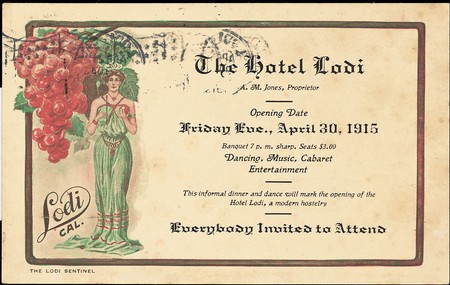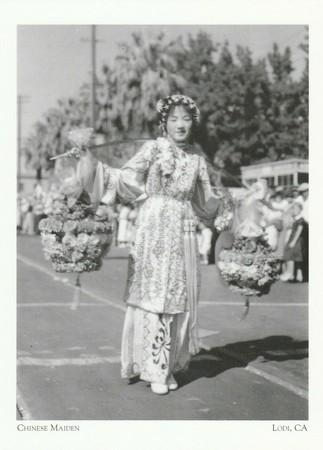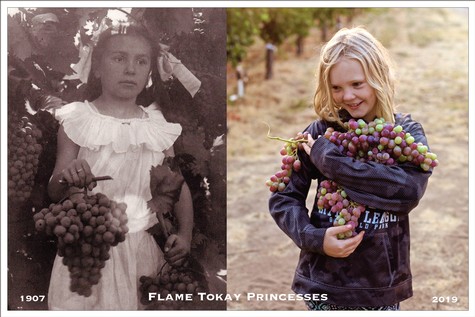MONDAY, AUGUST 15, 2022. BY RANDY CAPAROSO.
Featured image: Early 1900s colorized picture postcard depicting grapes arriving at Stockton’s El Pinal Winery, a winery founded in 1858 that contracted many of Lodi’s growers all the way through the 1930s.
Postcards, according to historians, have been utilized as a form of communication since 1848. The first private commercial postcards, printed without any images, were printed in Philadelphia in 1861. Usage of postcards quickly spread around the world; it was in France, in 1870 when the first picture postcards appeared.
Some of the most compelling historical records of the history of Lodi winegrowing are images captured in postcards. Although many of us, to this day, still enjoy the tradition of purchasing and mailing out postcards to family and friends wherever in the world we may travel—including the irony of getting back home to see the recipients of our colorful greetings even before the cards arrive in the mail—the “Golden Age of Postcards” is said to have been between 1890 and 1915.

One of the numerous different postcards sent out from the 1893 Chicago World’s Fair, also called the Columbian Exposition to celebrate the 400th anniversary of Columbus’ arrival in the New World.
The 1893 Chicago World’s Fair was undoubtedly a huge impetus. For many Americans, the souvenir images sent from Chicago were the first experience of picture postcards. Technical advances in photography, printing, and mass printing helped explode the popularity of the medium. Think of this as a way of sharing experiences that were as fun and exciting as any advances in communication—books, radio, moving pictures, picture magazines, television, and even the social media of today.
In 1905 alone, an estimated 7 billion postcards were mailed from state to state and all around the world, on every continent. As it was, the turn of the last century was also a pivotal time for the Lodi appellation. This was when this burgeoning community ensconced in the Mokelumne River watershed between the Delta and Sierras was just emerging from its “Wild West” stage.

Early 1890s colorized picture postcard of the watermelon harvest in Lodi, at that time still known as the “Watermelon Capital of the World” (by the late 1890s, grapes supplanted watermelons as the region’s leading fruit crop).
In the early 1900s, a huge influx of more pious settlers, many of German descent, were of like mind to clamp down on gambling and drinking establishments, and unregulated liberties such as allowing animals to roam freely through the dusty or (during the wet winters) muddy streets. Men’s and women’s civic organizations got together to discuss paving streets and building sidewalks, improving funding for local sheriff, fire, water, and sanitation departments, establishing an irrigation company, a public library, an opera hall, and any and all means of improving the local economy (led by farming) and quality of life.
Lodi citizens knew that the best way to accomplish all of this was to incorporate Lodi as a city, which they did in 1906 (see our post, 1906, when Lodi became a City and quit its lowdown ways).
The following is a visual record, starting with depictions of Lodi and Lodi wine country during this “Golden” era picture postcards, and ending with some of my own photographs converted into imaginary postcards, as a way of illustrating the appellation—easily the most productive winegrowing region in the U.S.—as we know it today. Enjoy!

In 1900: The home of Dr. Wilton Mason, the proud owner of Lodi’s first horseless carriage, located at the corner of what is now N. School St. and W. Elm Street in Downtown Lodi.

1890s postcard printed for Stockton’s El Pinal Vineyard winery and estate. Dr. Dean L. Mawdsley collection, California State Library.

Early 1900s view of Pine and Sacramento Street before the construction of the Lodi Arch, with the original Lodi Hotel to the left (across Sacramento from the Lodi Train Depot, which is out of this picture).

One of the earliest colorized picture postcards commemorating the Lodi Mission Arch, shortly after it was built for the 1907 Lodi Tokay Carnival.

1908 postcard showing “Wild Grape Vines” (native species) which Lodi’s original settlers found hanging from trees all along the Mokelumne, Calaveras, Cosumnes, and Dry Creek waterways.

Picture postcard (mailed out in 1909) depicting the nearly mile-long procession of grape growers entering the city beneath the Lodi Arch on the first day of the 1907 Tokay Carnival.

Dramatic arrival of “Queen Zinfandel” at the 1907 Tokay Carnival, turning down Sacramento St. from the Lodi Arch past the Beckman Welch Thompson Grocers store, owned and operated by three of Lodi’s leading citizens.

Picture postcard showing the 1907 Tokay Carnival’s Queen Zinfandel (center) and her “royal” court, consisting of local beauties all chosen by popular vote by the local populace.

1907 postcard celebrating Bertha de Almado, the 1907 Tokay Carnival’s “Queen Zinfandel,” holding a signature cluster of Flame Tokay.

1907 postcard depicting Fowler Barns, a Lodi farm planted to head trained Flame Tokay producing grapes that had by then become Lodi’s leading contributor to the local economy.

1909 picture postcard showing the bounties of Flame Tokay, the grape that brought prosperity to Lodi.

On a card postmarked in 1909, the landmark Hill House located across S. School St. from the U.S. Post Office; the Queen Anne Victorian style residence of George Washington and Mary Lewis Hill; later (in 1948) moved from Downtown Lodi to a neighborhood on S. Church St. where it is now an occasionally viewable museum.

1911 picture postcard proudly depicting a Woodbridge Irrigation Company canal bringing Mokelumne River waters to the vineyards.

1915 postcard printed for Hotel Lodi (not to be confused with the Lodi Hotel, torn down at the corner of Sacramento and Pine in 1912), built at the corner of S. School and W. Pine, across the street from the Lodi Opera House, and renowned for being one of the first hotels to feature rooms with their own bathrooms, showers, and telephones.

1915 postcard showing a Central California Traction Company electric streetcar on Lodi’s Sacramento Rd. at the corner of Pine St.; a passenger service that once ran from the Port of Stockton to Sacramento.

Lodi’s Mission Arch during the late 1950s; the postcard’s back-side proclaiming the region to be “The Home of the Flame Tokay Grape”

1959 rendering of Lodi winegrowing season painted by San Francisco’s John Garth on the walls of Lodi Grape Festival’s Grape Pavilion.

One of several postcards printed by Lodi’s El Rancho Motel during the 1950s, located on N. Cherokee Ave. parallel to Hwy. 99, during a time when the state route was the only way to get through California’s Central Valley.

1960s aerial of Guild Wine Company, on the east side of the Mokelumne River-Lodi area; the largest of the Lodi grower-cooperatives during an era when co-ops dominated the Lodi winegrowing industry.

1960s postcard for The Modern Hotel, located on S. Cherokee Lane (at the site where the Economy Inn currently sits).
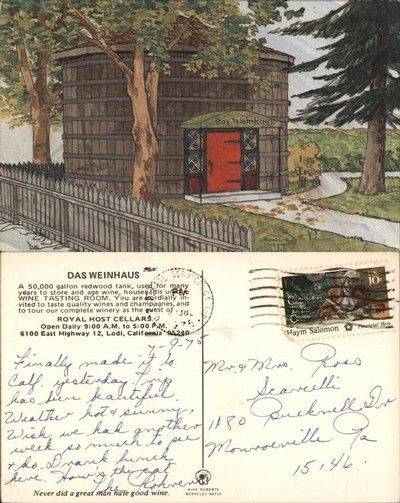
1975 postcard for Royal Host Cellars’ tasting room, built from a 50,000-gallon California redwood tank once utilized as Tank No. 150 by the old Roma Winery once located across the street (the tank was moved in 1965).

Modern day: The current Oak Ridge Winery tasting room, housed in the old Royal Host Cellars California redwood tank room.

Modern day: Lodi Walldogs mural resurrecting the image of a grape packer (“No smoking, no talking!”) once captured in a photograph displayed at the 1907 Tokay Carnival.

Modern day: Primitivo (a clonal variant of Zinfandel) harvest in Lodi’s Mokelumne River appellation.
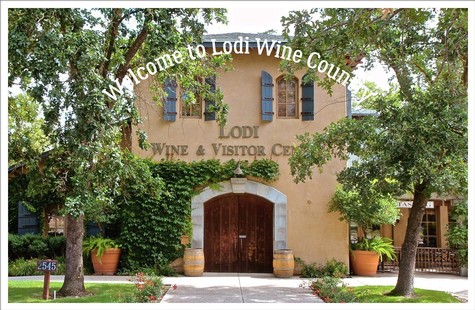
Lodi today: The Lodi Winegrape Commission’s (consisting of over 750 Lodi grape growers) office and visitor center.

Modern times: Historic railroad tracks, no longer used but still intact in front of Oak Ridge Winery and the long-defunct Roma Winery.

Modern times: The historic Lodi Arch with the California Golden Bear turned towards Sacramento (prior to 1956, the Golden Bear faced southwards, the bottom end pointedly facing the State Capitol).
Randy Caparoso is a full-time wine journalist who lives in Lodi, California. Randy puts bread (and wine) on the table as the Editor-at-Large and Bottom Line columnist for The SOMM Journal, and currently blogs and does social media for Lodi Winegrape Commission’s lodiwine.com. He also contributes editorial to The Tasting Panel magazine, crafts authentic wine country experiences for sommeliers and media, and is the author of the new book “Lodi! A definitive Guide and History of America’s Largest Winegrowing Region.”
Have something interesting to say? Consider writing a guest blog article!
To subscribe to the Coffee Shop Blog, send an email to stephanie@lodiwine.com with the subject “blog subscribe.”
To join the Lodi Growers email list, send an email to stephanie@lodiwine.com with the subject “grower email subscribe.”
To receive Lodi Grower news and event promotions by mail, send your contact information to stephanie@lodiwine.com or call 209.367.4727.
For more information on the wines of Lodi, visit the Lodi Winegrape Commission’s consumer website, lodiwine.com.
For more information on the LODI RULES Sustainable Winegrowing Program, visit lodigrowers.com/standards or lodirules.org.







